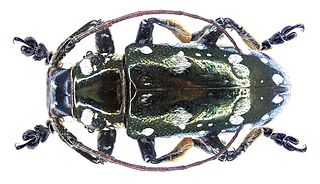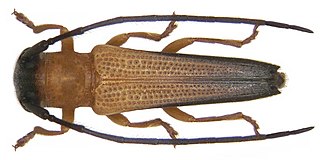
Xanthorhoe is a genus of moths of the family Geometridae described by Jacob Hübner in 1825.
Spulerina is a genus of moths in the family Gracillariidae.

Callichromatini is a tribe of beetles in the subfamily Cerambycinae, which include the following genera:

Pteropliini is a tribe of longhorn beetles of the subfamily Lamiinae.

Lamiini is a tribe of longhorn beetles of the subfamily Lamiinae.
Orinoeme is a genus of beetles in the family Cerambycidae, containing the following species:

Pothyne is a genus of beetles in the family Cerambycidae, containing the following species:

Eunidia is a genus of longhorn beetles of the subfamily Lamiinae.
Retifusus is a genus of sea snails, marine gastropod mollusks in the family Buccinidae, the true whelks.

Aristobia is a genus of longhorn beetles of the subfamily Lamiinae, containing the following species:
Monoxenus is a genus of longhorn beetles of the subfamily Lamiinae, containing the following species:

Nupserha is a genus of longhorn beetles of the subfamily Lamiinae, containing the following species:
Planodema is a genus of longhorn beetles of the subfamily Lamiinae, containing the following species:

Melipona quadrifasciata is a species of eusocial, stingless bee of the order Hymenoptera. It is native to the southeastern coastal states of Brazil, where it is more commonly known as mandaçaia, which means "beautiful guard," as there is always a bee at the narrow entrance of the nest. M. quadrifasciata constructs mud hives in the hollows of trees to create thin passages that only allow one bee to pass at a time. Because they are stingless bees, M. quadrifasciata is often used as pollinators in greenhouses, outperforming honey bees in efficiency and leading to overall larger yields of fruits that were heavier, larger, and contained more seeds.

Aristobia umbrosa is a species of beetle in the family Cerambycidae. It was described by James Thomson in 1865, originally under the genus Celosterna. It is known from Malaysia, Borneo and Sumatra. It contains the varietas Aristobia umbrosa var. variefasciata.

Aristobia voeti is a species of beetle in the family Cerambycidae. It was described by James Thomson in 1878. Although the name was originally spelled as "voetii", this spelling was not in use between 1894 and 2014, and therefore the spelling "voeti" must be preserved under ICZN Article 33.3.1, as this is the spelling that is in prevailing usage. It is known from Laos, China and Myanmar.

Aristobia reticulator is a species of beetle in the family Cerambycidae. It is known from Bhutan, Myanmar, India, China, Laos, Bangladesh, Thailand, and Vietnam. It feeds on Prunus persica, Liquidambar formosana, Quercus acutissima, Prunus salicina, and Nephelium mutabile. Many references list the name as Aristobia testudo, but this name, though published earlier, is unavailable under the ICZN, primarily in that Johann Eusebius Voet's 1778 work giving the name testudo fails to fulfill the requirement in ICZN Article 11.4 that a work must be consistently binominal; none of Voet's 1778 names, including testudo, are available.











